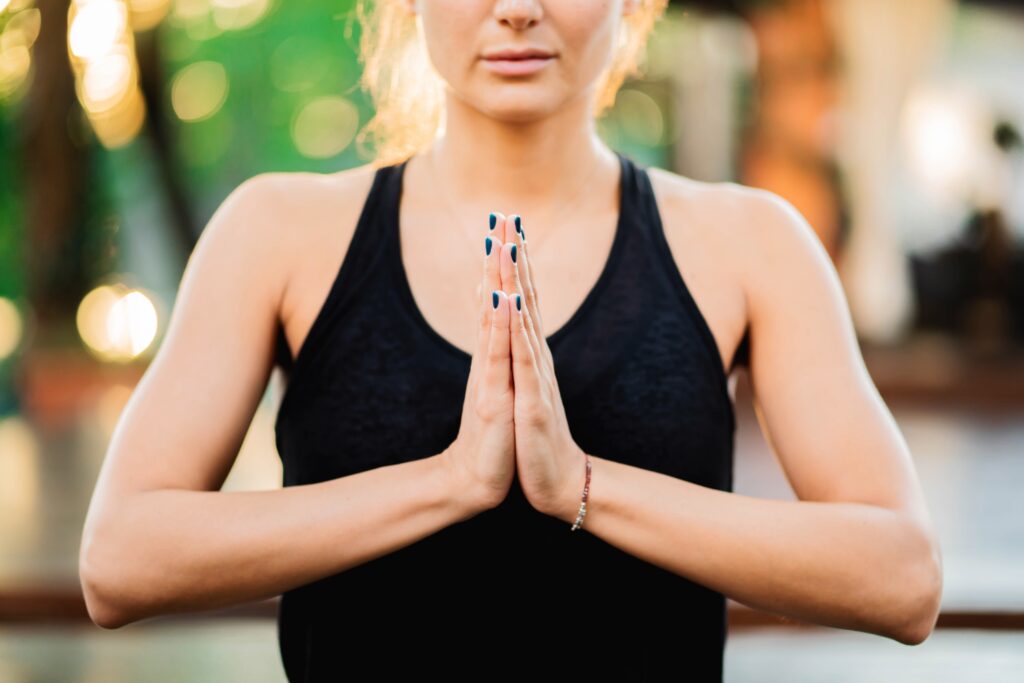Anxiety is undoubtedly one of the most common conditions of the 21st century – but why? Well, from full-time jobs to family life and enjoying small pleasures, we all have a hard time juggling it all. Paying taxes and monthly bills doesn’t help that much either, right? Add a pandemic and a war, and you get the perfect recipe for chronic anxiety.
However, you’re not lost! Big changes come with small steps – and the first ones you can do take just a few minutes per day. Take, for example, these simple mindfulness exercises that helped me and many other people overcome anxiety:

1. Deep breathing
See that photo above? That’s what deep breathing does when it comes to stress and anxiety: it relaxes you. When we are stressed or anxious, our breathing becomes shallow, which can actually lead to an increase in heart rate and blood pressure. By taking slow, deep breaths, we can activate the body’s relaxation response, which can help minimize these symptoms.
Deep breathing can also improve our overall physical health. It can help improve lung function and increase oxygen flow to the body’s cells, which can improve energy levels and overall well-being. In addition, deep breathing can help improve digestion and reduce symptoms of indigestion, such as bloating and constipation.
Furthermore, deep breathing can also have a positive impact on our mental health. By focusing on our breath, we can bring our attention to the present moment and let go of racing thoughts and worries. This can help improve our mood and reduce feelings of depression and anxiety.
Simply put, deep breathing can have a wide range of both physical and mental health benefits. By taking the time to breathe deeply, we can reduce stress, improve our physical health, and improve our mental well-being.
2. Body scan
Body scanning is a technique used in mindfulness meditation. In short, it means paying attention to the sensations in each part of your body, starting at the toes and working up to the top of the head. This can help to increase awareness of the present moment and release tension and stress.
Exercise: Lie down or sit comfortably, and bring your attention to each part of your body. As mentioned earlier, you should start at your toes and work your way up to your head. If you notice any sensations, tightness, or tension, and take a few deep breaths into that area.
3. Mindful walking
Mindful walking is a great practice of being anchored in the present moment while walking. It involves bringing your attention to the sensations of the body as you move, as well as the sights, sounds and smells around you. This can help you increase awareness and reduce stress and anxiety.
In addition, mindful walking can also improve physical health, as it is a form of low-impact exercise. By paying attention to the body as you move, you can also improve your posture and alignment, which is great for preventing injuries and chronic pain. Overall, mindful walking is a simple and effective way to add to your daily routine.
Exercise: Take a slow, mindful walk, paying attention to the sensation of your feet moving on the ground, the feeling of the air on your skin, and the sights and sounds around you.
4. Nature observation
Nature observation is quite similar to mindful walking since it is a practice that involves paying attention to the natural world around you. This can include the sounds of birds, the colors of flowers, or the patterns of leaves on a tree. When engaging in nature observation, it is important to focus on the present moment and just let go of any thoughts or judgments that may arise. This can help to increase awareness and reduce stress and anxiety.
Exercise: Spend some time outdoors, focusing on the sights, sounds, and smells of nature. Notice the colors, shapes, and movements of the plants and animals around you.

5. Gratitude practice
Practicing gratitude is the act of focusing on the things or events in your life that you are really thankful for. This can also include people, experiences, or possessions. By regularly practicing gratitude, you can improve your mental and emotional well-being. It can help to increase feelings of happiness and contentment and can also reduce stress and anxiety. In addition, practicing gratitude can also improve your relationships by helping you appreciate the people in your life. Overall practicing gratitude is a simple and quite effective way to improve your overall well-being.
Exercise: Take a few moments to think about something or someone in your life that you are grateful for. Feel the warmth and gratitude in your heart, and let it spread throughout your body.
6. Loving-kindness meditation
Loving-kindness meditation is a type of mindfulness practice that involves cultivating feelings of kindness and compassion for oneself and others. This can be done by repeating phrases or mantras that express love, such as “may I be happy, may I be healthy, may I be safe, may I live with ease.”
By regularly practicing loving-kindness meditation, you can increase feelings of love and compassion for yourself and others and improve your overall well-being. It can also help to reduce negative emotions such as anger and resentment, and improve your relationships with others.
Overall, loving-kindness meditation is an important practice for cultivating positive emotions and a kinder, more compassionate mindset.
Exercise: Sit comfortably and bring to mind someone you care about, or someone you want to forgive. Send them loving thoughts and well-wishes, and imagine the warmth of love emanating from your heart.
7. Mindful eating
As the name suggests, mindful eating is all about being aware of everything you put on the plate. Basically, you have to become aware of your hunger and fullness, as well as the taste, texture, and temperature of the food. Yes, this means you should stop snacking while binge-watching Netflix (sorry!).
Sure, it may seem hard at first, but you will improve your overall relationship with food and your body. You’ll reduce stress and emotional eating and improve digestion and metabolism in the long run.
Exercise: Take a small piece of food (or a sip), and pay attention to the sensations as you eat it slowly and mindfully. Notice the taste, texture, and temperature of the food, and savor each bite.
P.S.: Here’s a book that might help!
8. Sensory exploration
Sensory exploration means getting to know the sensations of the body and the environment around you. This can include the sensations of touch, taste, smell, sight, and sound. By practicing sensory exploration, you can increase awareness and reduce stress and anxiety.
This simple activity can also boost your concentration and problem-solving skills. Of course, sensory exploration can also help to improve overall well-being by engaging the senses and stimulating the brain. Overall, sensory exploration is an important aspect of mindfulness and can have many benefits for both the body and the mind.
Exercise: Spend some time exploring your senses, paying attention to every little detail around you, including the sights, smells, textures. Notice the details and nuances of your surroundings.
9. A mindful moment
Mindful moments are brief periods of time when you intentionally bring your attention to the present moment. This practice is probably the easiest one on our list because it doesn’t require any special equipment or training. Actually, I remember first starting mindfulness with this habit thinking “will this truly help?”
Turns out, it does.
Mindful moments can help to increase awareness and reduce stress and anxiety. They can also provide a brief respite from the demands of daily life and can help to improve overall well-being. In addition, practicing mindful moments can also help to improve concentration and focus and can make daily activities more enjoyable.
All in all, incorporating mindful moments into your daily routine is a surefire way to boost your mental and emotional well-being.
Exercise: Take a few moments to pause and bring your attention to the present moment. Notice any thoughts, feelings, or sensations that arise, and let them be without judgment.
10. Yoga or stretching
Yoga and stretching are so popular these days for good reason! These physical practices are fun, easy, and enjoyable for any age group. Both yoga and stretching involve moving your body in different ways to increase flexibility and strength. Of course, they also improve your joints – a key factor for seniors.
In fact, yoga and stretching can also have a soothing effect on the mind and can help to reduce stress and anxiety. By bringing awareness to the sensations of the body during these practices, you can also increase mindfulness and improve overall well-being. In a nutshell, incorporating yoga and stretching into a mindfulness routine can have many benefits for both the body and mind.
Exercise: Practice some gentle stretching or yoga, focusing on the sensation of the movement and the breath. Let your mind be calm and centered, and let go of any tension or stress.
Read also: 4 Breathing Exercises for Stress, Anxiety, and Worry








